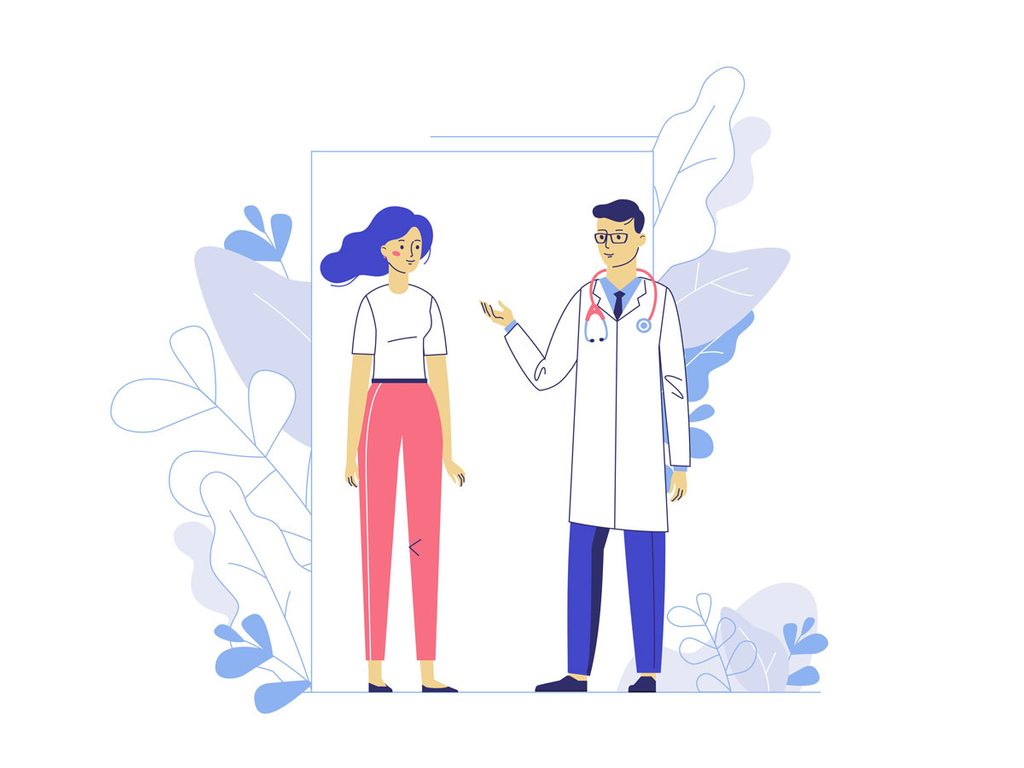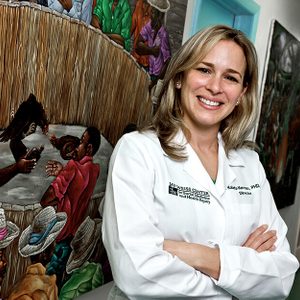Getting a Second Opinion from a Different Doctor Saved Me

A veteran RD health journalist shares hard-won lessons from her reporting—and from her family’s own health crisis in the US. Although healthcare is different in the US than it is in Canada, we can learn from her experience by valuing a second opinion.
In 2011, my husband, Pete, began having strange episodes of light-headedness. They lasted less than a minute and often happened when he exercised. He went to see his longtime primary care physician, who suspected he was dehydrated.
She prescribed Gatorade. But the episodes got more frequent and severe. One night at dinner with the kids, Pete completely zoned out. He didn’t understand what we were saying, and he wasn’t able to get any words out.
We immediately called his doctor, but we couldn’t get her on the phone. Her nurse referred us to a neurologist, but he had a six-week wait for an appointment. After some begging, we got in sooner, and he sent Pete for an MRI. The scan showed that Pete had a brain tumour the size of a golf ball.
Thankfully, after a long and harrowing journey, Pete has fully recovered, but my experience navigating that medical crisis now helps inform and inspire my work as a health journalist. If I had to distill everything I’ve learned over the years as a patient, spouse, parent, and medical reporter into one lesson, it’s this: Trust but verify.
While I believe most doctors have our best interests at heart, our system is deeply flawed.
Medical errors account for 28,000 deaths yearly in Canada, and they’re estimated to be the third-leading cause of death in the United States. News headlines about outrageous bills, conflicts of interest, and depersonalized care plant more seeds of doubt.
Doctors are keenly aware of the problems, but many of the underlying circumstances are beyond their control. Electronic record-keeping, a boon to efficiency in many ways, takes an average of nearly six hours of a primary care physician’s day—more time than is spent with patients. Most face-to-face visits are now about 15 minutes—and down to only eight minutes in some parts of the country, says Andrew Morris-Singer, MD, president of Primary Care Progress, a nonprofit working to improve primary care. “Physicians are literally running from room to room,” he says. “We have physicians tell us that they are constantly constipated because they can’t even stop to go to the bathroom.”
What’s more, insurance companies have cut doctors payments, forcing them to see more patients or invest in lucrative sidelines (such as selling supplements, medical devices, or imaging services) to keep their practices in the dark. These changes have driven a huge wedge into the patient-physician relationship, Dr. Morris-Singer says. (Find out what doctors secretly wish they could tell patients.)
This is not a minor concern.
Research shows that without trust a patient might not feel comfortable sharing information his or her physician needs to provide quality medical advice. Patients who trust their health-care providers are more likely to follow their treatment plans, have fewer symptoms, practice healthier behaviours, and be more satisfied with their care. In addition, a doctor who knows you and your health history is less likely to overprescribe or send you for unnecessary tests. Finally, I believe a doctor is more likely to make an extra effort for you if you have a relationship. It’s just human nature.
Building that relationship takes time and care, and sometimes that’s still not enough. Pete had been seeing his primary care doctor for almost a decade when he called about his light-headedness, yet he still had to wait three weeks for an appointment. Once he got in, she listened carefully as he described his symptoms, but she was out the door 15 minutes later. Would more time have yielded a more accurate diagnosis or an earlier MRI? It’s hard to know.
Maybe we can do more as patients.
Dr. Morris-Singer says it helps to show your doctors that you recognize the pressure they face. When your physician comes into the room, say something like, “How are you doing? I know it can’t be easy being in health care these days.” Asking about family, travel plans, or other personal details helps you connect on a human level.
When the exam is underway, ask your doctor whether you can see the notes he or she is typing (“Do you mind if I take a look?”), suggests Lolita Alkureishi, MD, of the University of Chicago, who has studied the impact computers have had on the doctor-patient relationship. I tried this at my most recent physical, and my doctor didn’t seem to mind. I even pointed out that the system still listed a prescription I was no longer taking.
Steven Feldman, MD, PhD, a dermatologist at Wake Forest School of Medicine, has his own strategy for building relationships with his patients. He discovered that they are more likely to take their prescriptions if he gives them a business card with his cell phone number and asks them to call him in three days to tell him how the medicine is working.
“They can’t believe I give them my cell phone number. It establishes both trust and accountability,” he says. Unfortunately, Pete’s difficulty getting in to see both his primary care doctor and the neurologist dented our confidence that he would get the care he needed. And then things got scarier.
The MRI showed that Pete had a meningioma, the “good” kind of brain tumour, the neurologist explained to us, because it is usually benign. But Pete’s was large, and it was wrapped around his carotid artery, pressing on his optic nerve and extending into the speech center of his brain.
(Psst: Here are some insider tips to become a smarter, healthier patient.)
The neurologist sent us straight to a neurosurgeon, supposedly the best in the city.
He spent an hour patiently answering our questions, but his prognosis was terrifying: The tumour needed to be removed, and the operation would likely leave Pete blind in one eye and possibly without the ability to speak. With Pete’s episodes of light-headedness occurring more frequently, the surgeon scheduled the surgery for the following week.
What happened next can be described only as a stroke of luck. Pete and I reached out to the rabbi at our temple for comfort, and she connected us with another congregant whose son had undergone surgery to remove a brain tumour a few years earlier. She encouraged us to get a second opinion from the neurosurgeon at Duke University Medical Center who had operated on her son. “He can do things other surgeons can’t,” she said.
As a health reporter, I knew objectively that a second opinion could be valuable. A 2017 Mayo Clinic study found that one in five people who sought a second opinion went home with a completely new diagnosis. Another 66 percent got new information or a revised diagnosis. A second opinion can also reveal different treatment options.
As Pete and I debated what to do, I understood why. Duke is a three-hour drive away, which seemed like a hassle. We liked the local surgeon. Most important, Pete couldn’t wait to get this thing out of his brain. But the woman from our temple insisted and even called Duke to get an appointment for us. That appointment changed everything.
The Duke surgeon told us he used a different technique.
It was lower risk, and it would spare Pete’s eyesight. If your doctor is irritated by your decision to seek a second opinion, as Pete’s local neurosurgeon seemed to be, it’s a red flag that perhaps he or she is not the right fit. Smart doctors won’t feel threatened or offended, says Robert Arnold, MD, chair of the University of Pittsburgh’s Institute for Doctor-Patient Communication. “They know that once you get that second opinion and come back, it’s way better, because you will both be on the same page about the best way to move forward,” he says.
To prepare for Pete’s appointment at Duke, I started reading up on meningiomas. I tried to stick to fact-based websites published by academic medical centers, such as Johns Hopkins, Harvard, and the Mayo Clinic. I also looked for condition-specific websites, especially those staffed with medical professionals. It may sound obvious, but being well prepared for appointments can help maximize what little time you have with your doctors and perhaps give them insights into your case they might not otherwise receive.
You should do your homework about your doctors too. While they may believe they are unbiased, physicians are not immune to money or gifts (including meals or speaking fees) they receive from pharmaceutical or medical-device companies. A ProPublica analysis found that doctors who take such payments are two to three times more likely to prescribe brand-name drugs compared with those who don’t. You can look up how much money your doctor has received (and from whom) on ProPublica’s Dollars for Docs site and the federal government’s Open Payments site.
If your doctor is listed, that doesn’t mean he or she has done anything wrong. But you may want to ask whether the medications you are taking are made by those companies and whether there are any cheaper generic alternatives. (FYI: These are the important questions to ask before you take prescription medication.)
Similarly, if your doctor offers a “cutting-edge treatment” not covered by insurance, look it up before you pay up.
I learned this lesson the hard way, when my podiatrist recommended a series of laser treatments for the arthritis in my big-toe joint. Five treatments and $750 later, my toe actually felt worse. “The treatments don’t work for everyone,” explained the doctor somewhat apologetically before she rushed off to see her next patient.
I later googled the type of laser therapy she’d used, and while some small studies showed good results, others were inconclusive. More ominously, perhaps, the device manufacturer’s website touted its profit-producing potential: “Start Creating a Cash-Based Division in Your Practice with Laser Therapy.”
When Pete was at the Duke hospital for his brain surgery, we wanted to connect with his medical team even though we would be there for just a short time—as with any relationship, I believed that personalizing our interactions would help ensure the best care.
I placed a family photo in the recovery room, not just to comfort Pete but also to remind the hospital staff that he was a husband and a father to three young children. I delivered bags of homemade chocolate chip cookies to Pete’s nurses. And we gave the surgeon a note from our eight-year-old daughter. It said, “Please take care of my daddy.”
When they finally took Pete into the operating room, I shed tears for the first time.
We had done our homework, followed every instruction, and chosen the best doctor. Now Pete’s life was in the surgeon’s hands. Eight hours later, he was wheeled to the recovery room. The operation was a success.
A few days later, a biopsy revealed that the tumour was a rare aggressive type of meningioma that exhibits cancer-like behaviour. The surgeon sent us to a Duke oncologist who recommended radiation to prevent a reoccurrence. She told us there were different types of radiation therapy but little consensus on which was best and to take our time making a decision while Pete healed.
As I researched our options, a physician friend sent me an article from a health portal that medical professionals rely on called uptodate.com. The information is dense, but it includes the latest evidence-based treatment guidelines for almost every condition, and it helped me understand the different types of radiation. Patients can access the site by paying a fee ($20 for a one-week subscription), and I often subscribe when a friend needs deeper information than what he or she can find on free sites.
After studying all the options, we talked with the oncologist and decided to do the radiation closer to home rather than under her care at Duke. But her honesty and understanding in that situation helped build the foundation for a physician-patient relationship that Pete values to this day. He treks to Duke to see her several times a year to make sure the tumour hasn’t returned. He often emails her with general questions about his health—even though he has a new primary care physician—and she always takes the time to reply. They developed something simple yet precious in their time together: a sense of trust.







